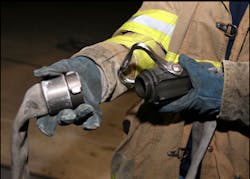Company Level Training - Splicing And Extending An Attack Line
You stretch a 200-foot preconnected line for an apartment fire, only to find out that the fire is in the building next door. What would you do and how efficiently do you think your crew would perform?
The scenario: You are dispatched to a reported apartment fire at 0200 hours. Enroute, you learn there have been multiple calls reporting this fire. You arrive on scene and find a three-story, wood-frame apartment building with heavy smoke showing. You cannot determine what floor the smoke is coming from because the smoke is too heavy.
You order your firefighter on the apartment side of the engine to pull a two-inch attack line: it is a 200-foot pre-connected line. The firefighter stretches the line through the breezeway to its full length, and then discovers that the fire is on the third floor of the building next door. What would you do and how efficiently do you think your crew would perform?
This exercise takes approximately 45 minutes. It can be done at the station, in a vacant lot, in a football field, or anywhere that you have enough room to pull about 400 feet of line. Repeat the exercise several times, using different methods.
The goal is to be as realistic as possible. Have your crew dismount from the engine or quint, pull a pre-designated line, carry any necessary tools, flake out the line, and prepare to make entry. Full turnout gear and air packs should be worn, although it is not necessary to be on air.
Once the line is extended and charged, have someone return to the engine to get another section of hose. This person also can be the officer or driver/engineer, depending on your staffing. Have them bring as much hose as you deem necessary.
Go through the procedure for shutting down the line, using proper radio traffic if that is your standard operating procedure. Disconnect the nozzle, connect the additional section(s) of hose and recharge the hose. Then advance the hose to a position of attack, which could be to the breezeway or the second floor of an apartment. Or you could simply open the nozzle from its fully stretched length on the ground.
This exercise should lead to a discussion of what method works best for your crew. Do you pull a section off another pre-connected line? Two sections? Do you take a smaller 1 3/4-inch line to splice in? These are questions that you have to answer for yourself. What works best for my crew in Fort Worth may not be suitable for your crew in upstate Washington. Be creative and let everyone express his/her thoughts.
Here are just a few ideas that you and your crew can toss around:
- Pull 100 feet (two sections) of 1 3/4-inch line from a pre-connected line to splice in to an existing 1 3/4-inch line.
- If you are using a 2-inch line, splice one or two sections of 1 3/4-inch line into your existing line. No adaptors are needed for this because the coupling size is the same.
- There has been some discussion within the members of my department about extended attack line lays. One thought was if you knew the lay was going to be further than your preconnects could reach, you should pull a 2 1/2-inch line and use a gated wye. You would then have the ability to run one or two 1 3/4-inch lines off of the wye. Any wye that is run off of a line smaller than a 2 1/2-inch, would not have the water volume to supply more than one line.
- Do you want to use a hose clamp when splicing in on an existing line instead of shutting down the entire operation?
- Does your department utilize break-away nozzles? You can add on additional lengths of 1 3/4-inch hose to complete the longer stretch without having to shutdown the charged line or utilizing a hose clamp. The firefighter assigned to bring the additional hose must remember that a second nozzle will be needed!
This exercise provides practice splicing in, and also allows you to determine what works best in various situations. You want to determine this on the practice ground. Our crew has had personal experience with this dilemma. I learned a few things in the heat of the moment that would have been better to know before hand. Having this discussion when everyone's belongings are burning upstairs is not a pleasant experience.
Related:
Larry Manasco has been with the Fort Worth, TX, Fire Department for 11 years and has has served as a lieutenant for the past three years. He holds the classification of Fire Officer I and Hazardous Materials Technician. He currently works in one of the busiest engine companies in Fort Worth. He has worked for Firehouse World in San Diego where he was an assistant instructor for FDNY B.C. Salka's "Get Out Alive" H.O.T. class. You can contact Larry by e-mail at [email protected].
